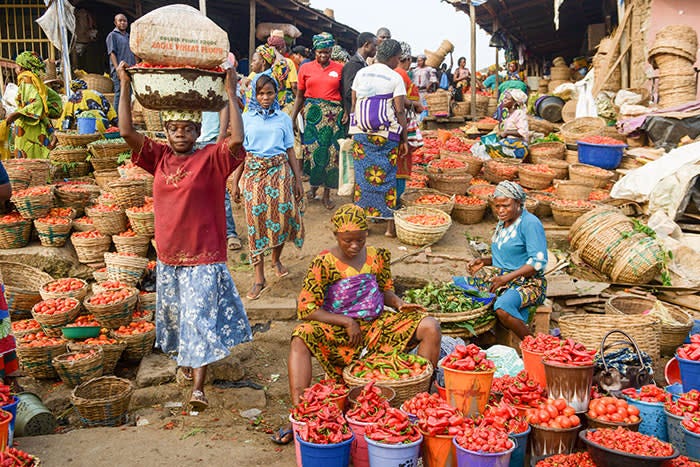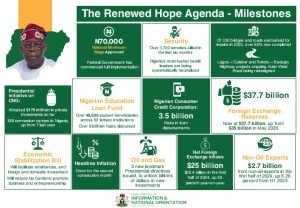There is hunger in the land and the whole populace is feeling it. Both the rich and the poor are feeling it.
This is because pressure of inadequacy and high prices of food, now out of the reach of the poor, has made all to share with others who do not.
As a result, those who appear to be rich are now poor because if you are rich or have sufficiency and your neighbour goes to bed hungry, you are not only poor; you are in in danger.
It is that bad in the region, which hitherto fed itself, especially during the early 50s and 60s, through the farming activities of rural settlements. Twenty farm settlements established by the government of the late sage, Chief Obafemi Awolowo, are not only bubbling due to government interest in farming but the rural settlements and villages daily shun out food to the semi-urban areas and cities, such that prices of foodstuff are predictable over the years.
Today , in the South West region, which comprises the six states of Lagos, Ogun, Oyo, Ondo, Osun, and Ekiti, the prices of food have gone beyond the reach of ordinary people.
In the last year, prices of garri, tomatoes, beans, yam, and other staple food items have increased by over 400 percent—four hundred percent—with the price of plastic garri, which used to cost N700 last year, now sold in the market for 3800. The same is true for tomatoes, yam flour, and others .
This is beside the price of rice, which has over the years become our stable food item and has reached an astronomical N80,000 per bag, forcing many households to drop it from their menu. Unfortunately, the alternative to rice too has gone out of the reach of ordinary people, as stated above .
Today, the general saying, Bi ounje bakuro ninu ise, ise buse’ meaning – when food is removed from the needs of the people, ,much of the problem of poverty has been resolved, is real.
Yes, we may have some living in affluence here and there, but today the ratio of poverty is spreading like bush fire because more hands have been removed from farming, resulting in famine.
There is less farming activity going on in the geographical landscape of the region, which is approximately 191,843 square kilometres of land . Today, the demography of the region, according to the Food and Agricultural Organization (FAO), as of 2006 is 27,722,437 square kilometres, the land area is 166,631, and there are 842,499 hectares of forest reserves.
Also, the fact that a reasonable portion of the cultivable part has been lying fallow over the years due to neglect by the government, which has shifted focus to monthly handouts from the federation account, has contributed greatly to the self-imposed famine that has plagued the region.
Another of the problems is the menace of bandits and herdsmen who trampled upon farms and ravaged them with their cattle with impunity. This is obviously due to a lack of punitive measures by the federal government, especially during the regime of former President Muhammadu Buhari.
The oil discovery in Nigeria in 1958, which came with unplanned wealth and a boom in the late 1960s and 1970s, blinded our sense of reasoning and made us lazy, to the extent of abandoning our natural source of living—farming.
Now, the price of that criminal neglect of the agricultural sector, which ordinarily is man’s first source of living before mineral resources are buried deep in the ground, has resulted in food inflation on a scale that has never happened in our history, not even during the intercine wars of the early centuries. The consequence is that prices of commodities have been left to the vagaries of demand and supply because the region could no longer feed its teeming populace, which has doubled over the years as a result of migration from other zones of the country as a result of insecurity, especially the North and the South. According to the Food and Agricultural Organization (FAO), Nigeria’s food inflation rate increased to 32.84%, which represents 8.72% higher than what was recorded in November.
Hence, when the governors of the region met in Lagos last week for their period meeting, they came out with a resolve to reverse the ugly trend and bring life and living to a tolerable level, as they met it when they were growing up as young children.
But then, the governors have to do more than talk but ‘walk the talk’ to change the distorted values of the region by reintroducing farming back to the senses of the people and taking practical steps to ensure integration, and farming must attract seriousness, as was done by the late sage Chief Obafemi Awolowo, who never imported food for the region and made Cocoa our natural import earnings, with which he developed the region to the envy of other two regions in the country.
His government established 20 farm settlements and five agricultural institutes all over the region, and this visionary step practically ensured food security as the institutes came out with new technologies for both subsistence farming and cash crops, with which the various landmarks in the region were developed and built.
Now, the question on the lips of people in the region who were old enough to feel the impact of his policies is: where are the farm settlements of Ado Odo, Ago Iwoye, Ajegunle, Coker, Ibi Ade, Ikenne, and Sawonjo all in Ogun State? Also the famous Lalupon farm settlements in Oyo State, Idanre, Orin-Ekiti, Fashola, Ilora, Eruwa,Ire Saadu, Akufo, and Ijaye in Ondo and Ekiti states. They have all disappeared. Thanks to successive military and civilian governments the region has been most unfortunate to have. What is left of the settlements are ageing farmers and infrastructure, with no replacement for them by the governors, who are now six in number.
In the area of livestock production, people are asking where Western Livestock Company, which created ranches in Oyo, Lagos, Ogun, and Osun states, produces livestock for the teeming populace.
An example is the Imeko cattle ranch in Ogun State with 4000 hectares of land with five dams and Oke- Afo with 12,000 hectares of land—all have been abandoned and left to rust over the years.
The price of that neglect is what we are paying today.
Between 1960 and 1970, agriculture contributed 55.8% to the gross domestic product (GDP) of the region but crashed to 28.4% in 2018, according to the Nigeria Bureau of Statistics (NBS).
Besides, only 34 million hectares of Nigeria’s 72 million hectares of agricultural land were cultivated.
Today, with a population of over 22 million, Lagos slaughters an average of 8,000 cattle heads daily, and this, with an average price of N500,000 for each cattle, amounts to N4b worth of cattle consumed daily . The region can take advantage of this and stop the importation of cattle from neighbouring countries, with the multiplier effect of creating employment for its teeming youths.
The various higher institutions and moribound training and research institutes in the region, like the Federal University of Agriculture, FUNAAB, Abeokuta,
Now that we have six governors in the region with more than enough cultivable land, it means more resources and more people, whose population has increased to at least 40 million, sixty-five of whom are youth.
For the declaration of the governors to boost food production and supply to have meaning, there must be conscious efforts during this rainy season to revive the dead twenty settlements, and with the growing population, each of the states needs at least ten farms to plant food and cash crops as per their capacity.
Now that the governors promised regional integration, each of the six states in the region must get build new settlements in addition to the revived moribund ones to produce farm products in their areas of comparative advantage .
Since Lagos, Ogun and Ondo are states surrounded by water, production of fish, which has become import-driven, has to be encouraged to produce enough protein for the teeming population.
There is no doubt that producing food requires guaranteeing the safety of the farms.
In this regard, the menace of bandits and terrorists in the area over the past five years has had its effects on food production and the supply chain. The six states must empower and equip the Amotekun more to combat the activities of these men, most of whom are from our neighbouring countries of Chad, Niger, Mali and Cameroon.
No sustainable activity could happen in the farming areas without the presence of enough security men.
What is more, the Development Agenda for Western Nigeria, DAWN, should also be encouraged to bring into reality its planned regional railway and electrical generation and transmission plans now that the sector have been unbundled from the limits of the unitary constitution by both former President Muhammadu Buhari and incumbent Bola Tinubu.
There is no doubt about the fact that the region have in its hands what it takes to banish hunger and poverty through its self-endowed natural resources .But lack of political will on the part of our Governors through by the proper application of far reaching programmes to revive agriculture and change the narrative of hunger and pervasive poverty which we have no reasons to live with in the first instance,.
Time to divest our reliance on oil as a means of sustenance is now and the earlier the governors activate the abundant human resources and natural endowment of the region,.
Agriculture for now remains the only sustainable means of growth and development as a people. for a nation that cannot feed itself is a slave to others






